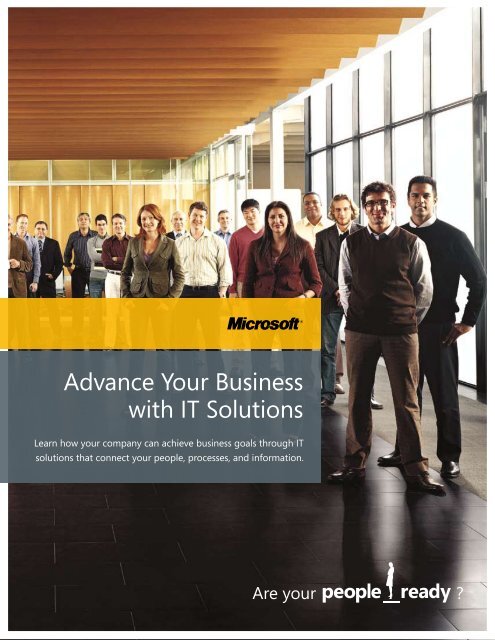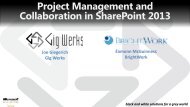Advance Your Business with IT Solutions - Gig Werks
Advance Your Business with IT Solutions - Gig Werks
Advance Your Business with IT Solutions - Gig Werks
You also want an ePaper? Increase the reach of your titles
YUMPU automatically turns print PDFs into web optimized ePapers that Google loves.
Today’s application environmentCompanies today are demanding that <strong>IT</strong> solutions support real-world business goals. Software has evolved beyondjust helping people create documents and read e-mail messages. Software now connects people <strong>with</strong> the informationand business processes needed to make better decisions. From the back-end infrastructure to the end-user tools,software is the key to empowering people to drive business outcomes.What kind of applications infrastructure do you need to create People-Ready solutions for your business? Theinfrastructure needs to be flexible, connected, and able to evolve <strong>with</strong> your business needs. That’s easy to say, butharder to achieve. Why? Enterprises deal <strong>with</strong> a range of <strong>IT</strong> complexities. Hard-coded business processes are bakedinto brittle applications. Disconnected silos of information often exist across the organizations. Integrating diverseheterogeneous systems often require inclusion of legacy applications. Development is slowed by complex tools,unpredictable processes and disconnects <strong>with</strong> the operations department. All of these issues become barriers to adevelopment department looking to create solutions that truly meet the needs of the business.Delivering the foundation for organizational agility and business successFor many years, business applications were written as rigidly coded units that were self-contained and, in manycases, inflexible and closed. Today, the reality is that most companies utilize a variety of different systems acrosstheir business areas. Often hundreds of downstream applications are built on top of these major systems. The keyis to connect the applications together in ways that support the required business scenarios—through serviceorientation and the mapping of core business processes. This will then help that the right information reaches theright people at the right time, through connected systems that are able to span the entire company.<strong>Business</strong>_Value_BrochureV3gz.indd4 412/3/07 2:08:22 PM
Connected UserExperiencesWebServicesData PlatformWebServicesBUSINESSPROCESSWebServicesWebServicesFigure 1. Next generation applications architecture overview.Next-generation applications architecture<strong>Business</strong> applications today are evolving into ones that blend the best of the consumer world—<strong>with</strong> rich,personalized experiences available across multiple devices and platforms—<strong>with</strong> the world of more traditionalcorporate applications, controlled by the <strong>IT</strong> department and provisioned centrally for business use. This newblended environment puts the user in control of the information they want, and can offer whole new levels ofrichness and interactivity. Many enterprises are evaluating how they can start to enable these new application types <strong>with</strong>in their own systems for customers and employees to use—and how these applications can pay off forthe business.Several core premises exist behind the architecture required to power these next-generation applications. First,businesses need to harness all the information across their company—<strong>with</strong>in databases as well as applications.Second, this information needs to be connected and loosely coupled through a service orientation and mapped tobusiness processes. Finally, applications <strong>with</strong>in the business need to leverage this exposed information and presentit to users in connected and compelling experiences.<strong>Business</strong>_Value_BrochureV3gz.indd5 512/3/07 2:08:22 PM
[Real-world service orientationGlobal Crossing simplifies order processing and reduces costsGlobal Crossing is a leading telecommunications provider of worldwide data and Internet Protocol (IP) networking services. Inthe past, most of its customers used labor-intensive business processes to manage orders received from customers. Orders wereroutinely touched by four different Global Crossing employees, who would enter redundant data into multiple internal systems.As order volumes grew, these manual processes became too time-consuming and costly for the company to maintain.To streamline order entry, Global Crossing implemented Microsoft BizTalk ® Server 2006—a business process management serverthat integrates disparate applications, systems, and technologies. By connecting each application to BizTalk Server through Webservices, data from different sources can now be shared in real time. Automating portions of the ordering process <strong>with</strong> BizTalkServer 2006 reduced or eliminated redundant entry of data, which lowered the cost of operating Global Crossing’s ServiceDelivery Order Desk by 25 percent and improved customer service. Electronic data transmission and storage requirements havebeen reduced while data integrity has improved. In addition, the new solution offers Global Crossing the scalability it needs tointegrate additional internal systems and processes.[“BizTalk Server 2006 has played an instrumental role in streamlining our operations. The new solution has helpedus move from a paper-intensive process to one that is automated, fast, and efficient.”—Kurt Utzman, Director of Service Delivery, Global Crossing, Ltd.SALES TEAM ORDER DESK NETWORK ASSIGNMENT VENDOR ORDERBEFORESales team entersorder into intelligentfront office applicationOrder agents transfer the informationto the Provisioning and NetworkInventory applicationProvisioning Specialistadds additionalinformation to the orderOrder is sent tosuppliers and monitoredfor progressSUPPLIER SYSTEMSAFTERSALES TEAMSales team entersorder into intelligentfront office applicationORDER DESKOrder agents handleminor manual workand any falloutBizTalk Server distributesinformation toprovisioning systemsOrder is sent tosuppliers and monitoredfor progressSUPPLIER SYSTEMSFigure 3. Global Crossing’s internal process before and after the implementation of BizTalk Server 2006.<strong>Business</strong>_Value_BrochureV3gz.indd9 912/3/07 2:08:26 PM
Managing your information <strong>with</strong> an enterprise-wide data platformInformation is everywhere across the modern-day enterprise. The ability to access and integrate disparate datasources in a mixed <strong>IT</strong> environment—across data stores, devices, and applications—is critical. Managing all thatinformation, however, presents multiple challenges for <strong>IT</strong> departments.First, the volume of data being generated today in most organizations is doubling every 12 to 18 months. Inaddition, applications now generate huge amounts of data that business owners want to be able to utilize.Meanwhile, hardware storage costs continue to drop, making it more feasible to store that data. <strong>IT</strong> departmentstoday also have to be able to manage a multitude of data sources beyond the server. Mobile devices, thumbdrives, and personal hard disk drives are widely used for data storage; in fact, much of today’s companies' datais stored outside the data center. Increased government regulations requiring companies to retain informationhave escalated too, creating yet another <strong>IT</strong> challenge. Multiple forms of data—including voice, instant messages(IM), e-mail messages, electronic and paper-based documents, along <strong>with</strong> Web-based interactions and LOBtransactions—must now be captured, stored, and made available for audit purposes.Managing information to satisfy all of these functional and governance requirements calls for sophisticated dataman-agement capabilities. Not only must the organization somehow manage the proliferation of information, andmake it available to all stakeholders who need to access it, the organization must also help keep it secure fromunauthorized users.Furthermore, in today’s highly connected business environment, information must be available in the office oron the go. Managing so many stringent requirements can be operationally challenging as well as costly. <strong>IT</strong> teamsneed to respond to business changes faster, manage geographically dispersed systems, and ensure that a disasterrecovery plan is in place for the infrastructure. The costs of managing explosive information growth are easilyoverwhelming <strong>IT</strong> budgets today in many organizations.Microsoft is committed to making information storage and retrieval manageable and cost effective for the enterprise.With Microsoft ® SQL Server 2005 as the data tier of the Microsoft application platform, organizations can build,deploy, and manage efficient and cost effective enterprise applications that scale to even the most demandingrequirements. SQL Server 2005 provides a host of capabilities to access, integrate, and manage disparate datasources. It allows any sized organization to achieve operational efficiencies through built-in deployment andmanagement tools, while providing a system that is designed for high availability, meaning better support formission critical business operations—as well as allowing for future scalability to accommodate growth.10<strong>Business</strong>_Value_BrochureV3gz.indd10 1012/3/07 2:08:26 PM
[Managing data across the enterpriseWeyerhaeuser reduces process time and improves performanceU.S. Department of Commerce reporting mandates require Weyerhaeuser to routinely collect and analyze extremely large andcomplex datasets under tight deadlines. The existing system had an unpredictable processing time that minimized the amount ofdata analysis that could be completed prior to submittal. Additionally, the <strong>IT</strong> staff often spent up to two hours creating reports forindividual users.Weyerhaeuser upgraded to SQL Server 2005, which provides accurate reports on sales data from across the company <strong>with</strong>in tightreporting deadlines. Now business users can quickly and easily create reports to meet the government’s detailed requests.Weyerhaeuser employees are using the freed up time to further refine the accuracy of the data they provide to the government,which has led to a reduction in the number of reports that Weyerhaeuser must submit to the Department of Commerce andhas also helped the company avoid providing further verifications of their sales. Weyerhaeuser expects to achieve a 373 percentreturn on the project <strong>with</strong> payback in three months.[“Scalability was a huge factor in our decision to move to SQL Server 2005…It’s good to know thatSQL Server 2005 will be able to support our very real expectation of long-term growth.”—Brad Chapman, Application Team Lead, Weyerhaeuser CompanySQL SERVER 2005SQL SERVER 2005LEGACY DATA SYSTEMSDepartment ofCommerce requestSQL Server Integration Servicescombines data from all over theWeyerhaeuser environmentDatabase cubesare built anddata is refinedReporting Services delivershigh-impact reportsData is analyzed andthe Department ofCommerce request isfilled on scheduleFigure 4. SQL Server 2005 delivers fast access to data at Weyerhaeuser, and isan example of leveraging the Application Platform Optimization model to driveinfrastructure enhancements. See page 17 for more details.11<strong>Business</strong>_Value_BrochureV3gz.indd11 1112/3/07 2:08:27 PM
Turning your business data into insight and actionAs global competition intensifies, companies want a more complete view of their business, customers and marketsto inform decision making. However, business intelligence (BI) tools have historically been too costly and complex todistribute amongst managers and workers throughout the entire organization. Consequently, the ability to makesuch tools widely available has never been an option. Microsoft is changing that. Specifically, Microsoft is focused onhelping all decision makers in the company get access to the information they need, and turn that information intoaction using familiar Microsoft Office tools they use every day.To achieve this, we have developed a complete end-to-end range of products and tools that support all facets ofdata storage, reporting, collaboration and analysis. SQL Server 2005 delivers a comprehensive BI platform providingintegration, analysis, and reporting capabilities; the 2007 Microsoft Office system enables users to easily access,understand, and distribute analysis of information. Now, tighter integration between SQL Server 2005 and the2007 Microsoft Office system empowers information workers to be more productive. They can answer their ownquestions in a security-enhanced environment that’s familiar and easy to use, freeing <strong>IT</strong> to focus its resources onhigher-value BI projects.Microsoft Office Excel ® 2007 has long been a favorite tool for analyzing multidimensional data and gainingbusiness insight. Office Excel 2007 brings new, more intuitive visualization features and tighter integration <strong>with</strong>the portal and database; employees can now more securely access, analyze, and share information from datawarehouses and enterprise applications. The <strong>Business</strong> Activity Monitoring (BAM) capabilities <strong>with</strong>in BizTalk ®Server 2006 enable real-time events from business processes to be analyzed by business users, who access theprocess-centric analytics through Microsoft Office SharePoint ® Server 2007 and <strong>Business</strong> Scorecard Manager. OfficeSharePoint Server 2007 comes <strong>with</strong> new and advanced collaboration features that make it possible for workers tointegrate data and interact <strong>with</strong> spreadsheets, key performance indicators (KPIs), and scorecards.Figure 5. A glance at Office Excel 2007 and <strong>Business</strong> Scorecard Manager.12<strong>Business</strong>_Value_BrochureV3gz.indd12 1212/3/07 2:08:28 PM
For <strong>IT</strong> and development teams, SQL Server 2005 includes: SQL Server Analysis Services for online analytical processing(OLAP), data mining, and data warehousing capabilities; SQL Server Integration Services (SSIS) for data extraction,transformation, and loading (ETL) functions; and SQL Server Reporting Services for easy-to-use, yet sophisticated,reporting capabilities. With this level of integrated functionality, development teams and database administrators canbuild complex analytical models from any source of business information and generate highly flexible, interactive reports.Gaining competitive advantage through superior user experiencesDesigning rich user experiences for business applications has traditionally been very difficult for developmentorganizations as part of the application development processes. With some exceptions, focusing on the userexperience during business application development hasn’t been widely practiced. Why? First, designers anddevelopers have traditionally been forced to work in different design environments. Second, mostly due to a lackof awareness, the user experience was largely unrecognized as a top-level requirement during development. As aresult, applications were deployed <strong>with</strong> non-intuitive interfaces and ran differently depending on the platform.It is clear, however, that <strong>with</strong> improved user experience and design, applications can deliver significant benefits foryour business. Some of these include:• Increased revenues: more users using your product, more often.• Greater efficiencies: internal users are more productive and satisfied.• Reduced support costs: easy to understand, fewer things that need explaining.• A better expression of your brand: positive user experience supports your brand.Microsoft believes that the user experience is a critical part of the application development process. We are committedto providing innovative tools, development frameworks, and operating platforms—as well as best practice guidance; toenable designers and developers worldwide to build rich, immersive, and compelling user experiences.Connecting the Design and Development WorldsIn the past, designers would communicate <strong>with</strong> developers using wireframes, JPEGs, and so on, thus losing designfidelity in the process that compromises the end user experience. Microsoft Expression ® is a new tool for professionaldesigners. Using Expression and mark-up/script languages such as XAML, XHTML, CSS, ASP.NET AJAX,etc., designers can collaborate <strong>with</strong> developers who are using Microsoft Visual Studio ® 2008 in the same projectfile—while still retaining their design fidelity in the process.13<strong>Business</strong>_Value_BrochureV3gz.indd13 1312/3/07 2:08:28 PM
Developing applications for Microsoft Windows environmentsWindows ® Presentation Foundation (WPF) takes full advantage of modern graphics hardware and an extensibleset of managed classes that developers can use to create rich, visually stunning applications. WPF also introducesExtensible Application Markup Language (XAML), which enables developers and designers alike to use an XMLbasedmodel to specify the desired user interface (UI) behavior. XAML and development tools built on it increasethe productivity of developers and designers by facilitating collaboration in the creation of applications that have auser interface component. User interfaces created in WPF can be used either in a Web browser or fully integratedinto any desktop application, providing a consistent and optimal customer experience regardless of the overallapplication architecture.Figure 6. Rich, compelling applications written for Windows Presentation Foundation.Using Office as a Development PlatformThe Office suite of applications has become the cornerstone of personal productivity for many end users today.Now these familiar applications have evolved to provide another level of value and versatility—as smart clients. Byproviding a rich object model for Word, Excel, Outlook ® and InfoPath ® , the Microsoft Office applications are nowcapable of functioning as smart clients to line of business applications. As fully programmable smart clients, theseapplications can now access and process information from across the enterprise, allowing users to employ the toolsthat they are most comfortable <strong>with</strong> and provide the greatest amount of functional productivity in their every daywork lives. For developers we have created the Microsoft Visual Studio Tools for Office that enable developers totake advantage of a “programmable” Microsoft Office interface.14<strong>Business</strong>_Value_BrochureV3gz.indd14 1412/3/07 2:08:29 PM
Enhancing the Mobile User ExperienceHand-held integrated communication devices now provide both business and personal users <strong>with</strong> a variety of usefulservices when mobile or away from the office. Windows Mobile ® 5.0 provides significant new capabilities that enablea rich user experience from mobile devices. In addition to e-mail and web browsing, Windows Mobile 5.0-enableddevices support a mobile version of the Office suite that is optimized for small form-factor communication devices—allowing business people to be productive away from the office. Windows Mobile 5.0 introduces new programminginterfaces (APIs) that provide drawing capabilities, easy interaction <strong>with</strong> device hardware such as cameras, andstraightforward integration <strong>with</strong> Pocket Outlook for customized applications. The Microsoft .NET Compact Frameworkincludes the Mobile Client Software Factory, tools and guidance to help developers create line-of-business WindowsMobile applications that interact <strong>with</strong> back-end systems over networks such as WiFi and GPRS. In addition,Microsoft SQL Server 2005 Compact Edition extends enterprise data management capabilities to mobile devices.Managing the application development lifecycleThe development process spans all stages of the application lifecycle—from design, development, deployment,management and retirement. Having an efficient and well-managed software development process means thatindividuals and teams can be more productive, lower the costs and work-item request backlog, optimize resourcesand speed time to market for new solutions. Many <strong>IT</strong> organizations implement tools and processes to supportthe Application Lifecycle Management (ALM) stages. The Microsoft application platform has tools, technologiesand best practices to support the individuals, teams and organizations involved in the development processfrom end-to-end.Reducing complexity leads to greater productivity, lower costs, optimized resources, and faster time-to-market, along<strong>with</strong> applications that give the business a competitive advantage. In an effort to better manage software development,many <strong>IT</strong> and development organizations turn to implementing tools specifically designed to support the ALM process.However, most past attempts to increase development productivity have either been too burdensome to implementor did not focus on core problems that affect team development. From the CIO’s perspective, too much of the <strong>IT</strong>budget has been allocated to activities that deliver a discouraging return on investment.The Visual Studio 2008 development system, provides an environment that makes it easier to unleash the powerof applications on top of the Microsoft platform. More specifically, the new Visual Studio Team System Suite ofproducts provides the tools needed for teams to manage the entire development lifecycle, including applicationdesign, development, and deployment. Streamlining tasks this way enables predictable, repeatable results <strong>with</strong>outtrading off productivity and innovation. Now all of Microsoft’s applications have a common customization andextension model, giving developers the ability to access these applications’ object models using standard APIs basedon the .NET Framework and XML.15<strong>Business</strong>_Value_BrochureV3gz.indd15 1512/3/07 2:08:29 PM
Teams that build business-critical applications have many participants who are not programmers; for example,business sponsors, project managers, architects, and testers. Moreover, these teams have become moregeographically distributed and specialized, so gaps form between role boundaries, creating conditions in whichissues can get dropped or plans can diverge unintentionally. For application development teams to be effective,communication must flow readily and must be integrated into daily activities, regardless of a team member’sphysical location. With Visual Studio Team System, Microsoft has addressed these challenges.Visual Studio Team System fosters better dialogue by opening new channels of communication between teammembers and by reducing the overhead of reporting. The team-based approach helps drive business value byaligning the right roles and teams across business and <strong>IT</strong>. Project managers can translate customer requirementsinto work items for the development team, and subsequently track the status of the work items to monitor projectstatus. By integrating process into the tools that team members use on a daily basis, Visual Studio Team Systemproducts lower the barrier to adopting automated and streamlined cross-functional development processes.Visual Studio Team System software supports the entire development team, including architects, testers, and databaseprofessionals. With the Visual Studio Team System family of products, organizations can reduce the complexity ofdelivering modern service-oriented solutions that are optimized for their operational environment. The launch ofVisual Studio Team System has enabled organizations to bring products to market faster, while lowering the costsof both development and lifecycle management. What is the ultimate benefit? <strong>IT</strong> departments can gain better ALMthrough the development process and allocate more resources to focus on business innovation.16<strong>Business</strong>_Value_BrochureV3gz.indd16 1612/3/07 2:08:29 PM
Putting it all together: the Microsoft application platform technology stackThe vision for the Microsoft application platform is to make its entire portfolio of products interoperable in anefficient and consistent way. Microsoft’s enterprise product stack incorporates this vision, helping organizationsachieve a dynamic application platform.ProductBenefits/FeaturesProvides integrated technologies and services such as a built-in, high-performance Web server;transaction management; Web services; a security-enhanced event log; support for messagequeuing; and an integrated management framework.Microsoft’s data management and analysis solution for the enterprise.Enables broad implementation of business processes that enhance how people interact <strong>with</strong>each other in real-world situations.Allows a new level of collaboration <strong>with</strong> customers, partners, and employees.MicrosoftOffice®®Provides a familiar user interface for customized business process and business intelligence solutions.5.0Delivers enterprise-level solutions to workers in the field.Provides a consistent development experience; Visual Studio Team System provides thecollaborative foundation for architects, developers, and testers to collaborate throughoutthe development lifecycle.Empowers professional designers to deliver superior user experiences.Planning your journey: Infrastructure OptimizationMicrosoft has developed the Infrastructure Optimization Model as a tool that allows us to work <strong>with</strong> ourcustomers to identify what their infrastructure maturity level is today, and build a comprehensive plan to evolvethe infrastructure based on <strong>IT</strong> or business needs. Some of the core areas of focus for customers when doing thisanalysis include:• Reduce infrastructure complexity and costs.• Improve operational efficiency and business agility.• Achieve an infrastructure that better serves business goals.• Select the right technology solutions for an organization’s specific size and business need.• Eliminate over-spending on technology that is not required.17<strong>Business</strong>_Value_BrochureV3gz.indd17 1712/3/07 2:08:33 PM
We have created the Application Platform Optimization (APO) model specifically for companies looking to analyze,understand and evolve their application platform capabilities. The APO model was developed using industry bestpractices and Microsoft’s own experiences <strong>with</strong> its enterprise customers. Microsoft’s APO model defines four levelsof maturity in the computing platform, each of which has specific and identifiable characteristics.Brittle,unconnectedapplicationsand platformsStandardsbased,flexiblebusinessapplicationsAdaptiveapplicationplatform drivingcore applicationsand businessprocessesFully serviceoriented,dynamicapplicationplatformCost CenterMost EfficientCost Center<strong>Business</strong> EnablerStrategic AssetBASICSTANDARDIZEDADVANCEDDYNAMICFigure 7. The four levels of <strong>IT</strong> asset maturity in the APO model.The first step in using this methodology is to ascertain the baseline maturity level of the <strong>IT</strong> assets <strong>with</strong>in anorganization. Once the baseline level has been established, the next step is to use the model to develop a plan toprogress through each level.Microsoft and its partners can help customers move through the infrastructure optimization journey. By working<strong>with</strong> Microsoft and using this model as a framework, an organization can quickly understand the business benefitsin moving from a “Basic” level (where the <strong>IT</strong> infrastructure is considered a cost center) to a more “Dynamic” level,where <strong>IT</strong> is viewed as a strategic business asset.18<strong>Business</strong>_Value_BrochureV3gz.indd18 1812/3/07 2:08:34 PM
Identifywhereyou areBASICSTANDARDIZED ADVANCED DYNAMICIdentifywhere youwant to be<strong>Business</strong> Process ManagementMove from disconnected applications and services to SOA and adaptive business processes.Data ManagementMove from managing disparate data silos to a scalable, integrated data management platform.<strong>Business</strong> IntelligenceMove from data silos and manual analysis to real-time and closed-loop analysis.User ExperienceMove from no User Experience awareness to proactive collaboration of design and development.Application DevelopmentMove from ad hoc development on legacy systems to modern, team development and managementthroughout the Application Lifecycle Management.Figure 8. Using the 5 core application platform capabilities to advance through the APO model.To learn more about APO and to take the assessment, visit www.microsoft.com/appplat.ConclusionSoftware and business applications play a critical role in empowering people and driving the business forward. However,legacy issues <strong>with</strong>in the application environment—such as hard-coded business processes, brittle applications,disconnected data sources, and complex development tools—hamper efforts to support business goals. Thisexplains why it has been difficult for <strong>IT</strong> teams to achieve the level of business agility required to support a peoplereadybusiness. And, it highlights the need for a new environment, where applications are designed for changeand delivered through a flexible <strong>IT</strong> infrastructure.The Microsoft application platform enables such a change. It gives <strong>IT</strong> and development teams the tools they needto build connected systems that bring together their people, processes, and information. For end users, these agileapplications open up new, more efficient ways of accessing the information they need to make better decisionsand drive organizational success. These improvements can lead to increased revenues, decreased costs, highercustomer retention, and closer partnering <strong>with</strong> suppliers and vendors. For <strong>IT</strong> departments, the Microsoft applicationplatform can transform your <strong>IT</strong> infrastructure from one that is costly and hard to manage, to one that is trulydynamic. This improved infrastructure has given many customers better productivity, dramatic cost savings andbetter business outcomes as a result.By focusing on the five core capabilities areas in your application environment—<strong>Business</strong> Process Management,Data Management, <strong>Business</strong> Intelligence, User Experience, and Application Development—you too can have adynamic platform upon which your applications can be designed, developed, deployed, and managed. Ultimately,this dynamic platform will help you achieve the goal of advancing the business through <strong>IT</strong> solutions, both now andin the future.19<strong>Business</strong>_Value_BrochureV3gz.indd19 1912/3/07 2:08:35 PM
www.microsoft.com/appplatConnectivity and synchronization may require separately purchased equipment and/or wirelessproducts (e.g., WiFi card, network software, server hardware, and/or redirector software). Serviceplans are required for Internet, WiFi and phone access. Features and performance may vary byservice provider and are subject to network limitations. See device manufacturer, service providerand/or corporate <strong>IT</strong> department for details.This white paper is for informational purposes only. MICROSOFT MAKES NO WARRANTIES,EXPRESS OR IMPLIED, IN THIS DOCUMENT.© 2006 Microsoft Corporation. All rights reserved.Are your ?<strong>Business</strong>_Value_BrochureV3gz.indd20 2012/3/07 2:08:42 PM





